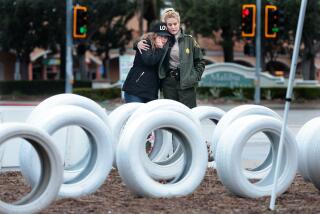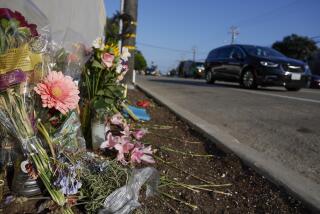Hit-and-runs between cars and bikes on the rise in L.A.
- Share via
Paul Livingston pressed his left arm to the pavement of Santa Monica Boulevard and slowly dragged his mangled body out of the street and onto the curb.
A car had just slammed into him at a red light in Beverly Hills, throwing him from his bike.
As paramedics lifted him into an ambulance, he heard a man nearby shout that the driver “just took off!” He blacked out.
That was June 2011. The musician, then 35, spent the next three years struggling to recover and to seek accountability from the woman who hit him and drove away.
Livingston’s case is part of a troubling trend. Hit-and-run collisions involving bicyclists surged 42% from 2002 to 2012 in Los Angeles County, according to a Times analysis of California Highway Patrol crash data.
The increase came as the overall number of hit-and-runs involving cars, cyclists and pedestrians dropped by 30%. Between 2002 and 2012, the most recent data available, nearly 5,600 cyclists were injured and at least 36 died in crashes in which drivers fled the scene.
The rising number of collisions underscores the delicate balance on Los Angeles streets, where more bicyclists are sharing lanes with vehicles. The number of Angelenos who are commuting by bike is slowly growing, federal data show. And in the last five years, Los Angeles has added more than 120 miles of bike lanes to promote safety and encourage more people to get out of their cars.
Nearly one-fifth of the hit-and-runs involving bicycles occurred in five neighborhoods: Long Beach, Santa Monica, downtown Los Angeles, Van Nuys and North Hollywood.
The collisions disproportionately injure the young. In 40% of cases, the victims were 18 or younger, the analysis found. The youngest was 1 and the oldest was 99.
For cyclists who are hit, a major frustration is how infrequently drivers are caught. The Los Angeles Police Department closed one in five hit-and-runs from 2008 to 2012, meaning about 80% were unresolved, according to data the department reported last year to the Board of Police Commissioners. Less than half of those cases were closed through an arrest.
The chance of being convicted is so slim that “if you wanted to murder someone, it would almost be better to just hit them with your car,” said Assemblyman Mike Gatto (D-Los Angeles), who has pushed for stiffer hit-and-run penalties.
Traffic investigators say that they are faced with thousands of hit-and-run collisions a year involving bikes, cars and pedestrians, and they must focus on cases with strong leads, such as eyewitness reports or the car’s license plate number, and on crashes that kill or maim the victims.
“There are a lot of cases where we don’t have a lot to go on,” said Sgt. Daniel Dail, who works in the Sheriff’s Department’s traffic services detail.
::
Six days after the crash, Livingston awoke in the intensive care unit at Cedars-Sinai Medical Center. He had been in a medically induced coma while surgeons raced to stop his internal bleeding. Eight vertebrae were fractured. His pelvis was sheared in half.
Kept awake by pain, he hallucinated that he was riding his bike. “I was so scared, and in so much pain,” Livingston said.
At his bedside, his mother told him there might have been progress in his case.
The day after the crash, Victoria Chin had called the Beverly Hills Police Department. The 24-year-old from Los Angeles said she had hit a cyclist the night before, according to the police report. There was nowhere for her to stop or turn around, she said, and she hadn’t known what to do.
An investigator asked Chin to bring her car to the station so they could photograph any damage.
She arrived the next day with a lawyer and photos of her car, according to the police report.
Without the vehicle as evidence, the investigating officer wrote, “I was not interested in booking her.... Had it not been for Chin turning herself in, there were no workable leads... and the case would have been closed.”
Livingston left the hospital a month after the crash with 10 titanium screws in his back, hip and pelvis, and more than $1 million in medical bills. He lost his job at an instrument rental company because he could no longer lift heavy gear. He lost his apartment when disability payments didn’t cover the rent.
“All it took was a split-second, and then nothing was the way it had been before,” Livingston said.
At the end of 2011, with the criminal case stalled, he sued Chin in civil court, seeking unspecified damages.
By the next fall, a long scar marching up Livingston’s abdomen was the only visible sign of his surgeries. Cycling still scared him, so he took up jogging for exercise.
Livingston called the Los Angeles County district attorney’s office frequently. He said an assistant district attorney told him they needed evidence that proved Chin was driving at the time of the crash.
Fleeing the scene of an accident in which someone was killed or severely injured, as Livingston had been, is a felony punishable by up to four years in prison and $10,000 in fines. Drivers convicted of misdemeanor hit-and-run — typically, cases in which no one was seriously injured — can face up to $1,000 in fines and less than a year in jail.
Livingston’s lawyer hired a private investigator, who found one of Chin’s former roommates. In a deposition, the roommate said Chin had admitted hitting a cyclist, Livingston said. A year and a half after the collision, in November 2012, the district attorney’s office charged Chin with felony hit-and-run.
The former roommate and the assistant district attorney who prosecuted the case did not respond to requests for comment.
As the criminal case wound through the courts, Livingston attended every hearing.
Chin initially pleaded not guilty to one count of felony hit-and-run. In May, nearly three years after the accident, she changed her plea to no contest. She was sentenced to 120 days in jail and ordered to pay more than $638,000 in restitution, most of which will go toward Livingston’s medical debt.
After two days behind bars, inmate records show, Chin was released from jail under a county policy that allows immediate release for women sentenced to less than 240 days.
“I was in a coma for longer than she was locked up,” Livingston said. So far, she has paid Livingston $24.42.
Chin was unemployed at the time of the crash, according to court documents, and no longer lives in Los Angeles. A judge approved a request for her to perform community service out of state.
Her attorney declined to comment on her behalf, citing a “very heated and ongoing” lawsuit.
::
Victims’ advocates say that police don’t investigate hit-and-run cases aggressively enough. If drivers saw punishment as a real threat, they contend, they would flee less often.
Law enforcement agencies say that hit-and-runs of any kind are among the most difficult crimes to solve. Most cases have little or no evidence. Drivers rarely turn themselves in. Instead, many rush to cover their tracks — repainting, smoothing dents, changing the vehicle’s plates and allowing any alcohol to clear their bloodstream.
At the urging of bicycle advocacy groups such as Finish the Ride, started by a cyclist who lost his leg in a hit-and-run in Griffith Park, state legislators have made a recent push to stiffen penalties to discourage drivers from leaving crash scenes.
Some drivers see cyclists simply as another object slowing down their commute, said Ted Rogers, a cyclist and advocate who writes the blog Biking in LA. The sheer size of Los Angeles allows others to believe that they can escape unnoticed. Neither attitude will change until the laws do, Rogers said.
Gatto introduced a bill this year calling for a sixth-month suspension of the licenses of drivers who are convicted in hit-and-run collisions involving another person. Gov. Jerry Brown vetoed Gatto’s bill in September, saying “current law is adequate.”
Brown vetoed four other bills related to hit-and-runs, including another by Gatto that would have used the state’s Amber Alert system to display information about hit-and-run suspects on highway signs near the collision site. The legislation was modeled after a system in Denver, where police issued alerts in 17 cases over two years and made arrests in 13 of them, city officials there said earlier this year.
In his veto memo, Brown said California’s Amber Alert system is expanding to issue information about missing people who are developmentally disabled. Adding more information, he said, might overwhelm the system.
More than three years after the crash, Livingston has a new apartment and is playing drums in a Pasadena reggae band. He has tried to let go of the anger, pain and frustration of the last three years. Loud noises and heavy traffic still put him on edge, though. And his bike sits unused.
“My life is getting back on track. I know it could be much worse,” Livingston said. “But nothing will ever be the same.”
More to Read
Sign up for Essential California
The most important California stories and recommendations in your inbox every morning.
You may occasionally receive promotional content from the Los Angeles Times.












